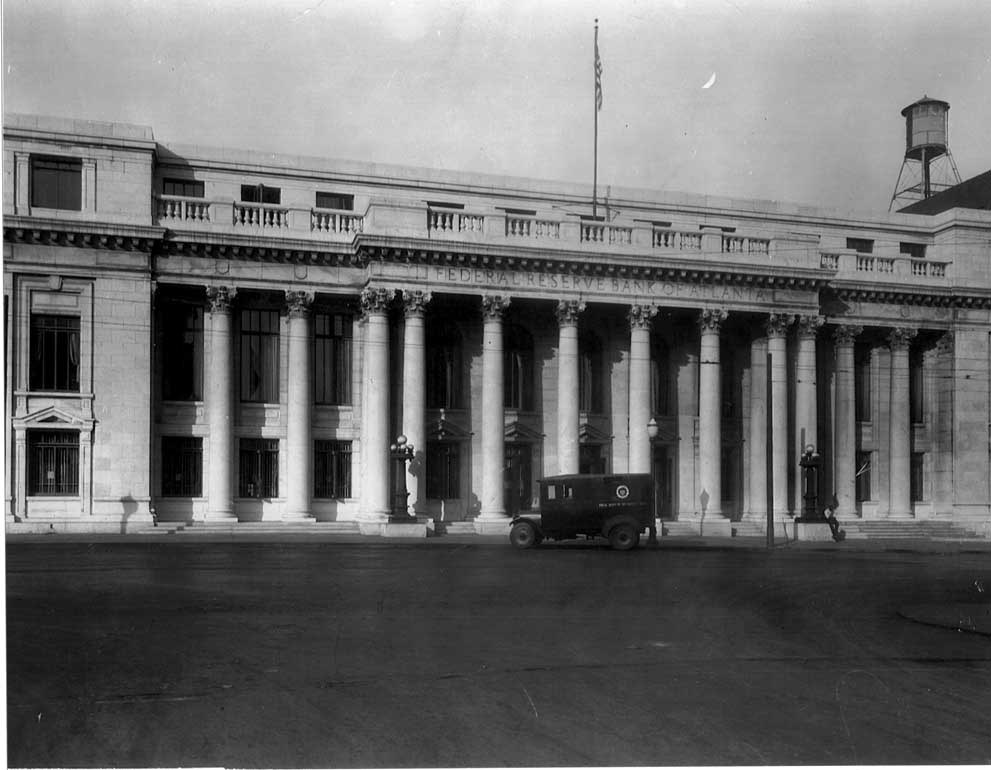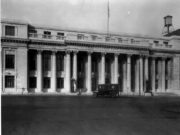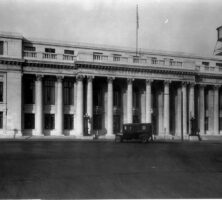Federal Reserve Banks, which serve as the operating arms of the Federal Reserve System, the nation’s central bank, are charged with a unique set of responsibilities.
Reserve Banks participate in setting national monetary policy, supervise numerous commercial banks, and provide a variety of financial services, including cash, check, wire transfer, and automated clearinghouse transaction processing, to depository institutions and the U.S. government. While other organizations have roles in each responsibility, the Federal Reserve is the only organization with responsibility for all three.
The Federal Reserve System was created in 1913, when U.S. president Woodrow Wilson signed the Federal Reserve Act. Its original objective was to provide the nation with a safer, more flexible, and stable monetary and financial system, acting through Reserve Bank boards of directors and presidents. At the time, the Federal Reserve Bank of Atlanta was charged with serving the Sixth Federal Reserve District, encompassing Alabama, Florida, Georgia, and sections of Louisiana, Mississippi, and Tennessee, a territory it still serves today.
From rented space in Atlanta’s Hurt Building, the Atlanta Federal Reserve Bank opened for operation on November 16, 1914. During its first years the Atlanta Fed sought to strengthen the cotton economy of the Sixth District and minimize dependence on New York banks. Officials also sought to enroll banks in the Federal Reserve System. The Sixth District opened the first branch of the Federal Reserve System in New Orleans, Louisiana, in 1915. Additional branches opened in Birmingham, Alabama, and Jacksonville, Florida, in 1918 and in Nashville, Tennessee, in 1919. In 1918 the Atlanta Fed moved into its own building, located on Marietta Street in downtown Atlanta, where it remained until 1964.

Courtesy of the Federal Reserve Bank of Atlanta
In the Sixth District, enrolling banks in the Federal Reserve System was initially a challenge. During the 1920s the number of banks enrolled in the system slowly increased, but it declined after the 1929 stock market crash. During the early 1930s the Atlanta Fed assumed the assets of many failed banks.
Some of the resistance that banks had to joining the Federal Reserve System involved its commitment to clearing checks at par, or at face value. Most banks in the 1920s and 1930s withheld a small fee when clearing a check. Federal Reserve Banks cleared checks at face value and supported eliminating nonpar checking, without much success. In 1941 almost 90 percent of the district’s nonmember banks did not clear checks at par. The Atlanta Fed supported a bill that moved through Congress in 1944 seeking to eliminate nonpar banking. The bill passed the House but was defeated in the Senate. The last vestiges of nonpar banking ceased in the district in the early 1980s, when Louisiana ended the practice.
The 1930s saw changes to the Federal Reserve System as the nation struggled through the Great Depression. In 1933 the scope of bank examinations expanded to levels similar to those used today. The Banking Act of 1935 centralized monetary policy formulation through the creation of the Federal Open Market Committee, which included the presidents of each reserve bank. The Atlanta Fed now had a stake in creating national monetary policy. Recognizing that analyzing economic information is vital to the formulation of monetary policy, in 1938 the Atlanta Fed hired an economist to manage a research and statistics department and to create a research library.
Expansion and new processes were the hallmark of the 1950s for the Atlanta Fed. Check volume increased throughout the district, and the Atlanta Fed branches in Jacksonville, Nashville, and Birmingham built new buildings to accommodate this growth. In 1954, after a policy change, the Atlanta Fed ceased shipments of unfit currency to the Federal Reserve Board in Washington, D.C., and began to incinerate unfit currency in Atlanta.
The 1960s saw the growth of automation, a trend that continues to this day. Machines were purchased to assist the check-clearing process for the Sixth District, reducing the personnel required to process checks while enabling the bank to process an ever-growing volume of checks. The Atlanta Fed built a new headquarters building at the same Marietta Street site in 1964, and a New Orleans branch expansion was completed in 1966. Continued growth in Florida’s economy led to the creation of the Atlanta Fed’s Miami branch in 1975.
In the 1970s the Atlanta Fed began developing electronic payments systems and point-of-sale transaction systems. Working with the Georgia Institute of Technology, the Atlanta Fed developed and introduced an automated clearinghouse (ACH) in 1973. This became a prototype for ACHs in other reserve districts. Machines that verified, counted, and sorted currency were introduced in 1978. These machines increased currency processing from 760,000 bills a day processed by 21 employees to 2 million bills a day processed by 15 employees.
In 1980 Congress passed the Monetary Control Act (MCA), which made reserve requirements—or funds that banking institutions must put aside in reserve—mandatory for all depository institutions. The MCA also required the Federal Reserve System to provide check-clearing and electronic funds transfer services to all depository institutions and charge fees for these services, instead of providing these services free to member banks.
During the 1980s the Atlanta Fed continued to increase automation and to innovate its financial services in an effort to remain competitive while responding to changes in the district. Meanwhile, by 1989 the supervision and regulation division at the Atlanta Fed counted 103 examiners, reflecting the increased complexity of banking, and had begun to participate in bank examinations in other countries.
In the 1990s the Atlanta Fed became the headquarters for the system’s Retail Payments Office, which was established to direct the strategic retail payments activities of all reserve banks. The importance of bank supervision increased with new federal regulations for commercial banks. The research function not only supported monetary policy deliberations but also conducted research into wide-ranging topics like financial derivatives, the changing southeastern workforce, and emerging markets in Latin America. By the mid-1990s, with employees working in three Atlanta buildings, the Atlanta Fed made plans to consolidate its staff into a new building in Midtown Atlanta.
With the completion of new headquarters at 1000 Peachtree Street in 2001, the Atlanta Fed continues to meet the needs of the banks and the public in the region in the twenty-first century.





